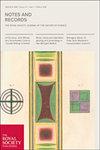乔治·辛克莱(约1630–1696)的流体静力学作品:忽视与批判
IF 0.6
3区 哲学
Q3 HISTORY & PHILOSOPHY OF SCIENCE
Notes and Records-The Royal Society Journal of the History of Science
Pub Date : 2018-04-11
DOI:10.1098/rsnr.2017.0044
引用次数: 4
摘要
苏格兰自然哲学家乔治·辛克莱(或辛克莱)(约1630–1696年)是英国最早的流体静力学作家之一。1662年,他访问了伦敦,会见了罗伯特·马里爵士和罗伯特·博伊尔,并在皇家学会留下了一篇论文手稿。学会从未记录过收到这件作品的情况,辛克莱觉得自己受到了不公平的对待。1669年出版了拉丁语版本《Ars nova et magna gravitis et levitatis》,1672年出版了《Hydrostatics》。辛克莱的所有作品都受到詹姆斯·格雷戈里和威廉·桑德斯在1672年《衡量虚荣的新艺术》中的谩骂和笔名批评。本文对辛克莱的生平进行了总结,并考察了他与英国皇家学会、格雷戈里和桑德斯之间的纠纷。有人认为,尽管辛克莱有其他局限性,但他对流体静力学的了解是相当多的,对他的批评被夸大了。然而,他的工作后来被忽视了。辛克莱的处理揭示了学术竞争和早期皇家学会的程序。本文章由计算机程序翻译,如有差异,请以英文原文为准。
The hydrostatical works of George Sinclair (c.1630–1696): their neglect and criticism
The Scottish natural philosopher George Sinclair (or Sinclar) (c.1630–1696) was one of the earliest British writers on hydrostatics. He visited London in 1662, when he met Sir Robert Moray and Robert Boyle and left a manuscript treatise at the Royal Society. Receipt of this work was never recorded by the Society, and Sinclair felt that he had been dealt with unfairly. A Latin version, Ars nova et magna gravitatis et levitatis, was published in 1669, followed by his Hydrostaticks in 1672. All Sinclair's works were vituperatively and pseudonymously criticized by James Gregory and William Sanders in The Great and New Art of Weighing Vanity of 1672. Here, Sinclair's life is summarized, and his disputes with the Royal Society and with Gregory and Sanders are examined. It is argued that, despite his other limitations, Sinclair's knowledge of hydrostatics was considerable, and that the criticisms made against him were exaggerated. Yet his work was subsequently neglected. Sinclair's treatment sheds light both on academic rivalries and on the procedures of the early Royal Society.
求助全文
通过发布文献求助,成功后即可免费获取论文全文。
去求助
来源期刊
CiteScore
1.50
自引率
0.00%
发文量
45
审稿时长
>12 weeks
期刊介绍:
Notes and Records is an international journal which publishes original research in the history of science, technology and medicine.
In addition to publishing peer-reviewed research articles in all areas of the history of science, technology and medicine, Notes and Records welcomes other forms of contribution including: research notes elucidating recent archival discoveries (in the collections of the Royal Society and elsewhere); news of research projects and online and other resources of interest to historians; essay reviews, on material relating primarily to the history of the Royal Society; and recollections or autobiographical accounts written by Fellows and others recording important moments in science from the recent past.

 求助内容:
求助内容: 应助结果提醒方式:
应助结果提醒方式:


